|

This
article is from Danish Another World nr. 1,
November 2003.
The magazine can be ordered at www.another-world.dk
 Danish article
Danish article
 German article (Free MIND no. 2, December 2003)
German article (Free MIND no. 2, December 2003)

Lars
Najbjerg [Photo: Thorsten Overgaard]
THROUGH
THE PINHOLE
By:
Thorsten Overgaard
On
a warm August day with teenagers sun bathing on the coast,
two F-16 fighters are flying in patrol formation above the
ocean. Far above the clouds the sun beams are brightening
the view that stretches over several hundred kilometers on
all sides of their cockpits, and down at a few white clouds
scattered in the sky. The noise from the jets is surprisingly
quiet in the cockpits as the fighter jets cut their way through
the freezing sky at 950 km/hr, 14 kilometers above the ocean,
while twenty five liters of fuel are transformed every minute
into a white line stretching behind each fighter.
As
they approach the Russian territory, twelve miles from Kaliningrad
and the Russian millitary base, they reduce their altitude
to 100 meters where the air is thicker and the fuel comsumption
rises above sixty liters of fuel every minute. The pilots
keep an eye on their instruments. A scanner will alert them
of any detection by Russian radar stations, but so far nothing
happened.
Suddendly
however, a short alarm beeps as a Russian radar station detects
their presence. Warnings are being issued on the international
mayday radio frequency. Shortly after a Russian Sukio fighter
jet is on their trail. Short orders sound on the radios and
the two F-16s turn down along the border over the ocean towards
international air space.
The
standard operating procedure for Russan fighters is to fly
their jets behind an enemy and lock their missiles so that
they can launch them the exact second a jet passes the border.
There is no mercy and it requires a sensible decision to control
the situation intelligently. Even though the fighters are
still some miles away from Russian territory it is not taken
too lightly. Time is scarce, the lead pilot gives out a short
order and the two Danish fighters take a sharp turn to the
right low above the ocean. The Russian fighter flies by above
them and seems to have lost them on his radar. The Danish
lead pilot gives out another short order and the two Danish
fighters accelerate and chase the Russian. The Russian pilot
still hasn’t detected them and the Danish lead pilot
fighter appears on the Russian’s plane’s side
while the second Danish F16 fighter is placed in shooting
range behind him.
Now
all three fighters are in international air space heading
away from the Russian air space.
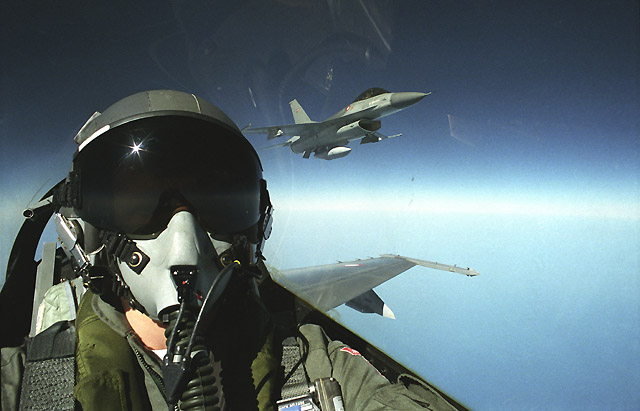
Lars Najbjerg [selv portrait,
private photo]
They wave to each other
The Danish lead pilot tilts his wings up and down, which is
the international sign for grouping into formation with him.
This is however not neccesarily the rule for Russians pilots.
But, surprisingly, the Russian accepts the invitation and
moves into close formation with the Danish F-16, wing to wing,
so close that they can easily see from one cockpit to another.
They fly like that for a while, kind of hand-in-hand, while
the two pilots exchanges signs and wave to each other, until
the Russian makes a sudden and fast acceleration upwards and
turns back towards Kaliningrad. The Danish pilots haven’t
got fuel enough to follow, even if they wanted to.
”We
got him... but only with a camera. It was a cool moment.”
The
year was 1995, five years after the Berlin wall went down.
Back on the ground a sunny day in Denmark. Lars Najbjerg is
lying on the grass while he tells the story, his pilot jacket
is hanging peacefully on the apple tree and his wife is inside
the house, painting the first floor.
Both
of them just returned from a four year stay in Great Britain
and now their house is being renovated after having been rented
out. He is dressed in a white T-shirt with a two-F16-fighters
motive and white paint stains of the same color as the newly
painted walls of the living room.
Lars
Najbjerg is a distinguished graduate pilot from the
NATO flying school in Texas, Sheppard Air Force Base. This
is the story of how a boy dreamt about flying, made it through
the pinhole and materialized his dream of wings.
”I’ve
always wanted to become a pilot. At five years I started asembling
and flying my first model planes. When I was sixteen I parachuted
... I guess because I thought it to be a practical preparation
as a pilot. So you can get down, in case.”
”Whenever
people asked what I wanted to be, I would answer pilot., nobody
believed that, so most often the comment was that it was purely
impossible. But always, as long as I can remember, I wanted
to become a pilot. In fact there was nothing else I wanted
to become, I never had any plan B.”
”Before
I was 18 I started taking lessons to get a civilian flying
certificate but my instructor there got me onto the right
track. He had a military background and said I had to be pretty
stupid not to take the top-education the military could offer.”
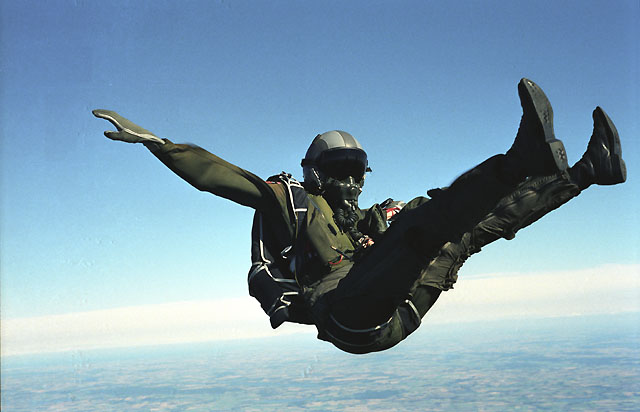
LLars Najbjerg in flight suit – and in free fall
[private photo]
Hundreds
of applicants narrowed down to 5 pilots
At the age of 18, Lars Najbjerg applied for the test to become
a fighter pilot. A mighty small pinhole where the applicants
are thoroughly screened even before the tests. From a large
number of applicants a group of only fifty is allowed to do
the test itself. And from that test none or only one continues
on the yearly selection of 20 pilot applicants that actually
start training at the military flight base. After a number
of flying tests 15 go out and only 5 remain and are sent to
the prestigious Sheppard Air Force Base in Texas to go through
a topnotch education to become fighter pilots.
”Already
when I was parachuting I rather quickly realized that if is
not the physical obstacles but the mental that limits one's
performance. So I began reading books on psychology. When
I found Dianetics, I was on my training as a civilian pilot
and I thought to myself ”here it really is, here is
a precise method to move your limits instead of a whole lot
of blah-blah.” You don’t fly an aircraft by feeling
and believing as many of the psychology books suggest. There
is a precise method to flying. The Dianetics book and books
on flying had a practical and useable method to the subject
- they were very much alike. That was what appealed to me
when I first read the book Dianetics.”
Although
the test for military pilots is a long haul of five days stretching
physically the applicants limits from dusk till dawn, Lars
Najbjerg felt himself well armed:
”Just
the fact that you have the knowledge about what is stopping
you from doing something you would like. ... well, that just
changes everything. Then you don’t blame other things
such as bad genes, a tough childhood or what other reason
you could find. Just the fact that you can identify the correct
cause by yourself means a lot. When I went for the test I
hadn’t yet experienced Dianetics but had read both Dianetics:
Evolution of a Science and Fundamentals of Thought, and that
helped me for sure.”
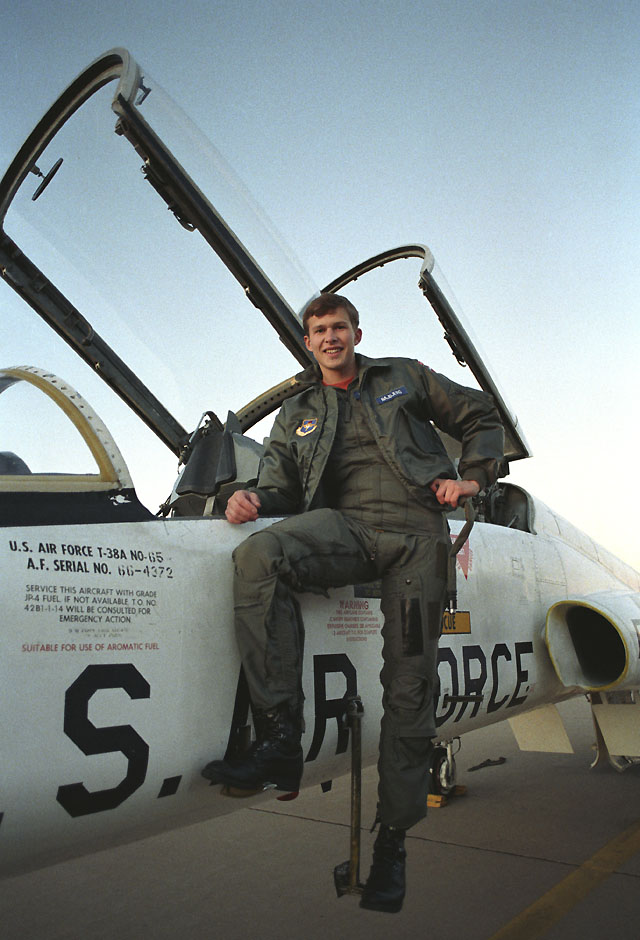
Lars
Najbjerg at Sheppard Air Force Base [private
photo]
The
art of becoming a good pilot
The pilots are being trained for 13 months at the base in
USA and then complete the rest of their education in Denmark.
Lars Najbjerg found himself particularly fascinated by ”Close
Air Support” where one flies at 900 kilometers an hour
about 30 to 100 meters above ground in order to supply air
support to soldiers at the very front.
”You
fly as low as you dare, probably even lower in a real war.
When flying too high it’s easier to hit the target but
equally easy for others to hit you. When you leave the base
you don’t know your target yet. You get told when you
get there what specific needs the guys in the front have.
A soldier in the front points out the target when he sees
you coming in. He would for example say ”One o clock,
3 kilometers” which would indicate that the target is
3 kilometers ahead in the direction One o’clock, even
you yourself can’t see it visually yet. So you arrive
with 900 kilometers an hour, see the target, say a enemy tank,
when it is 300 meters away from you. You have to aim, hit
it bulls eye, get up and away in one and a half seconds approximately
from that instant you actually see the tank. That is one of
the most challenging disciplines where you get all the way
out to the limit of what you can handle.”
”I
have always wanted to test myself, find my limits. When you
fly fighter jets, you pretty soon discover that it isn’t
a matter of how much the plane can take, but what YOU yourself
can take mentally that sets the limits of performance.
”Of
course there is a physical stress, for example when you are
turning and are being exposed to a pressure of nine times
gravity.
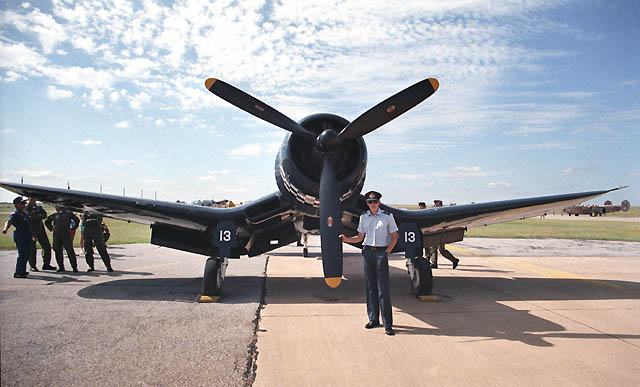
Old love... Lars Najbjerg by a propellar from WW II.
[private photo]
”When
you have learned to live with the physical stress, there is
only the mental barriers left to conquer.”
The goal of Dianetics is for a person to become Clear, that
means a person in his best possible or optimum condition.
For Lars Najbjerg to become Clear meant an astonishing difference
in life and in flying.
”I
wanted to be become Clear, get rid of my reactive mind (reactive
mind: the part of the mind which stores past painful experiences).
It was pretty real to me that THAT was what was limiting my
mental abilities and thus my abilities as a pilot. The goal
for me was to become the best I possibly could.
”I
have an example that might illustrate the difference. Before
I went clear I had once taken off with a Cessna 172 propeller
plane and was flying away when the engine slowly stopped.
I hurried to look for a field to land on while at the same
time was sending mayday messages on the radio. I clearly remember
how little power I had to analyze the situation. I had practically
no power over anything except throwing the plane down on the
first and best field. After landing it was not a good feeling.
I saved myself and the plane, but the situation could have
been avoided if I had just pulled the carburator heater –
as carburator ice was the reason for it.”
”Shortly
after I became clear I was testing my Giles 202 art plane.
I was testing different kinds of spins, a maneuvre where the
plane is flown out of control and just rotates directly towards
the ground. And as I’m spinning, the engine suddenly
stops! Instead of getting sweaty fingers and act in a kind
of panic I got the plane under control and horizontal, and
then started analyzing what the problem was with the engine
until I got it started again. When the situation was under
full control I went up again and did the same spin to see
if the engine would stop again. And it did! After repeating
it for a while I found that it had to do with the centrifugal
force and could adjust the engine. When I span right the engine
stopped but not when I span left!
”There
was a big difference in the way I controlled the situation
before and after clear. Only due to the fact that the limit
of what I could mentally accomplish had been moved. I had
gotten more power.”
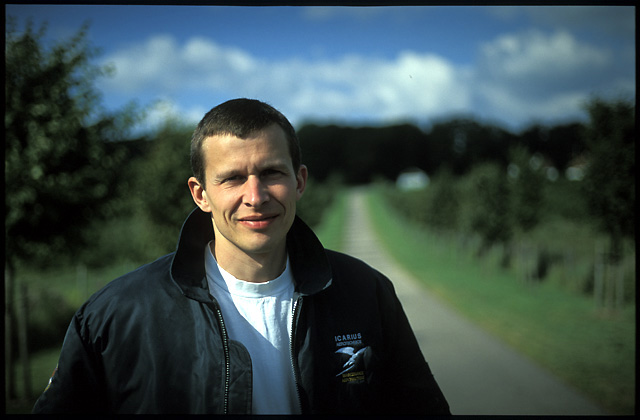
Lars Najbjerg [Photo: Thorsten
Overgaard]
Moving
mental borders
While working as a fighter pilot, Lars Najbjerg was also starting
an aviation company with three of his friends where they sold
planes and spare parts. In 1998 he had retired from the military
and sold his shares in the aviation company and moved to Great
Britain to study Dianetics and perfect his knowledge of the
mind and its barriers. The result being that he today is as
topnotch a professional in the Dianetics method as he is in
flying.
”The
military was a good education, but I had to move on. Basically
I’m not for war, I had to realize. But I like to fly,
and I like to expand my abilities. That is why I went to UK
for some years.”
”It
is a great satisfaction helping others to develop mentally.
I have heard that it is a problem recruiting new qualified
pilots because the mental attitude – people's attitude
– has changed. Instead of going for it, you give in:
”Well-yer, if it is to difficult to become a pilot I’ll
have to find something else to do,” seems to be the
common attitude. People have learned to live with their limitations
rather than moving and expanding their abilities to what they
find is needed.”
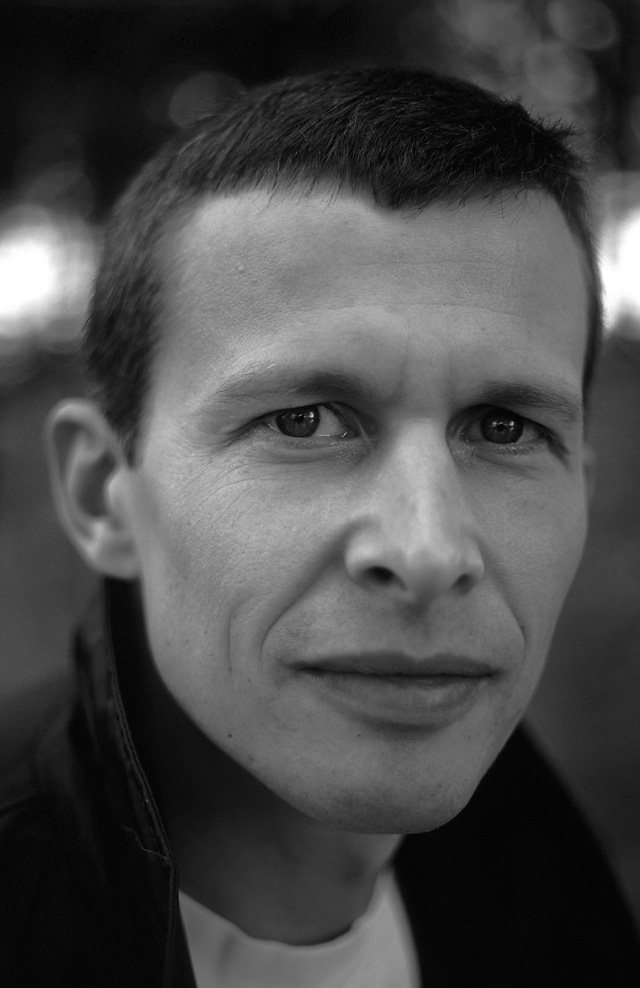
Lars Najbjerg [Photo: Thorsten
Overgaard]
A toy for daredevils
While Lars Najbjerg studied in Great Britain he also found
time to assemble his new toy that came as a build-it-yourself-kit.
A Giles 202 art plane, probably not as well known to most
people as Ferrari. But for pilots and such it is the topnotch
plane.
”You
rehearse different disciplines such as loops, spins, etc.
And then there is competition around the world. You fly inside
”the box” which is a space in the air of 1 x 1
x 1 kilometer that you have to perform within the limits of,
and then five judges on the ground are giving you points for
your performance. You fly partly your own program, partly
a program you recieve from the judges shortly before the competition
takes place.
”When
you live an ordinary daily life, your limits are rarely tested.
But when you enter a high stress environment as the one in
an art plane, your encounter limits quite clearly. And no
matter how good you are, you can always get out there and
find your limits, it is just a matter of making the program
tougher.”
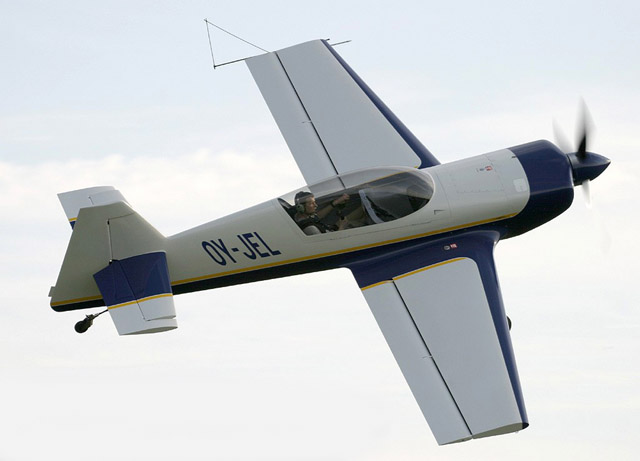
Lars Najbjerg in his Giles 202 art plane which is parked in
a hangar near by his home.
[Photo:Thorbjørn Brunander Sund, Danish Aviation
Photo]
Thorsten
Overgaard, November 2003
|
![]()